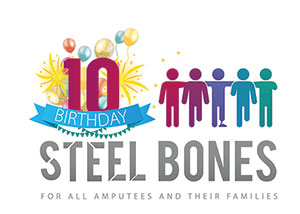Losing a limb/limbs brings many changes to daily life—and one of the most common questions we hear at Steel Bones is:
“Will I ever be able to drive again?”
The short answer is: yes, many amputees do return to driving, and it can be a key part of rebuilding independence and confidence. Here’s everything you need to know about getting back on the road safely and legally.
Step 1: Inform the DVLA
If you’ve had an amputation, you must notify the Driver and Vehicle Licensing Agency (DVLA). This doesn’t mean you’ll automatically lose your licence—it just means they’ll assess your fitness to drive and make any recommendations.
You can do this online or by completing the G1 form. Your GP, prosthetist, or rehabilitation team can help you with the process.
⚕️ Step 2: Medical Assessment or Driving Assessment
Depending on your individual case, the DVLA may ask you to attend a mobility or driving assessment, often at a local Driving Mobility Centre.
This is a supportive experience—not a test—and is designed to help find the safest and most comfortable way for you to return to driving. They may recommend:
-
Adaptations to your car (e.g. hand controls)
-
An automatic vehicle instead of manual
-
Refresher lessons with a specialist instructor
Step 3: Adaptations and Equipment
There are lots of clever solutions available to make driving possible and enjoyable again:
-
Left-foot accelerators
-
Hand-operated brake/accelerator systems
-
Steering wheel aids
-
Transfer boards or swivel seats
You may be eligible for help with vehicle adaptations through the Motability Scheme or local grants—ask us for guidance.
✅ Step 4: Back Behind the Wheel
Once cleared, and if your car has the appropriate adaptations (if needed), you’re legally allowed to drive again. For many amputees, this is a major milestone in reclaiming independence, work, and social life.
Take it one step at a time. Be kind to yourself, and don’t rush. It’s okay to feel nervous—it’s a big deal! But with support and proper guidance, it’s absolutely achievable.
️ We’re Here to Help
Steel Bones is here to support you at every stage of your journey. If you’re unsure where to start, or want to speak with someone who’s been through it, reach out to us. We can signpost you to:
-
Driving Mobility Centres
-
Trusted instructors
-
Adaptation suppliers
-
Peer support from other amputees who’ve returned to driving
Final Thoughts
Getting back behind the wheel is not just about transport—it’s about freedom, confidence, and control. And you deserve that.
If you’re considering driving again after an amputation, don’t do it alone. Talk to us, talk to others, and take it at your own pace.
Need help with driving-related questions? Contact Steel Bones today. We’re just a call away.
✉️ hello@steelbone.co.uk
www.steelbone.co.uk
Organisations That Support Driving Accessibility
1. Driving Mobility
www.drivingmobility.org.uk
The national network of independent mobility assessment centres (previously known as RDAC and other centres). They offer driving assessments, advice on adaptations, and guidance on returning to driving after amputation.
Over 20 locations across the UK.
2. Motability Scheme
www.motability.co.uk
Provides affordable access to cars, powered wheelchairs, and scooters for disabled people using mobility allowances. They also cover vehicle adaptations through their grants programme.
Ideal for those receiving PIP/DLA.
3. Disability Rights UK
www.disabilityrightsuk.org
Offers guidance on legal rights, driving assessments, and DVLA processes. Also provides factsheets and help with appeals and benefits related to mobility.
4. Queen Elizabeth’s Foundation for Disabled People (QEF)
www.qef.org.uk
Provides specialist mobility assessments, advice on car adaptations, and driving tuition. Their mobility services are highly rated.
Based in Surrey, but accept referrals from across the UK.
5. RICAbility (via Research Institute for Disabled Consumers)
www.ricability.org.uk (now integrated with RIDC)
Publishes user-reviewed guides on accessible products, including adapted vehicles, car controls, and driving equipment.
6. The Forum of Mobility Centres (FoMC)
www.mobility-centres.org.uk
Network of approved driving mobility assessment centres. Their website helps locate your nearest provider.
7. Your Local Council / Adult Social Services
Most local councils offer Occupational Therapist assessments and may fund or part-fund vehicle adaptations based on assessed need.
8. The Vehicle Re-Engineering & Adaptations (REA) Specialists
A wide range of private adaptation firms exist, including:
-
Des Gosling Mobility
-
Elap Mobility
-
Autochair
-
Adapted Vehicle Hire (AVH)
Always check they are Motability-approved and offer post-installation support.
9. British Red Cross / Local Charities
Some local branches offer volunteer driving assessments, support transport, or grants toward adaptations. Also helpful for temporary transport needs during recovery.
DVLA (Driver and Vehicle Licensing Agency)
www.gov.uk/contact-the-dvla
You must notify DVLA after an amputation. They may request a medical report or assessment. Failure to inform them can lead to fines or licence suspension.


Recent Comments